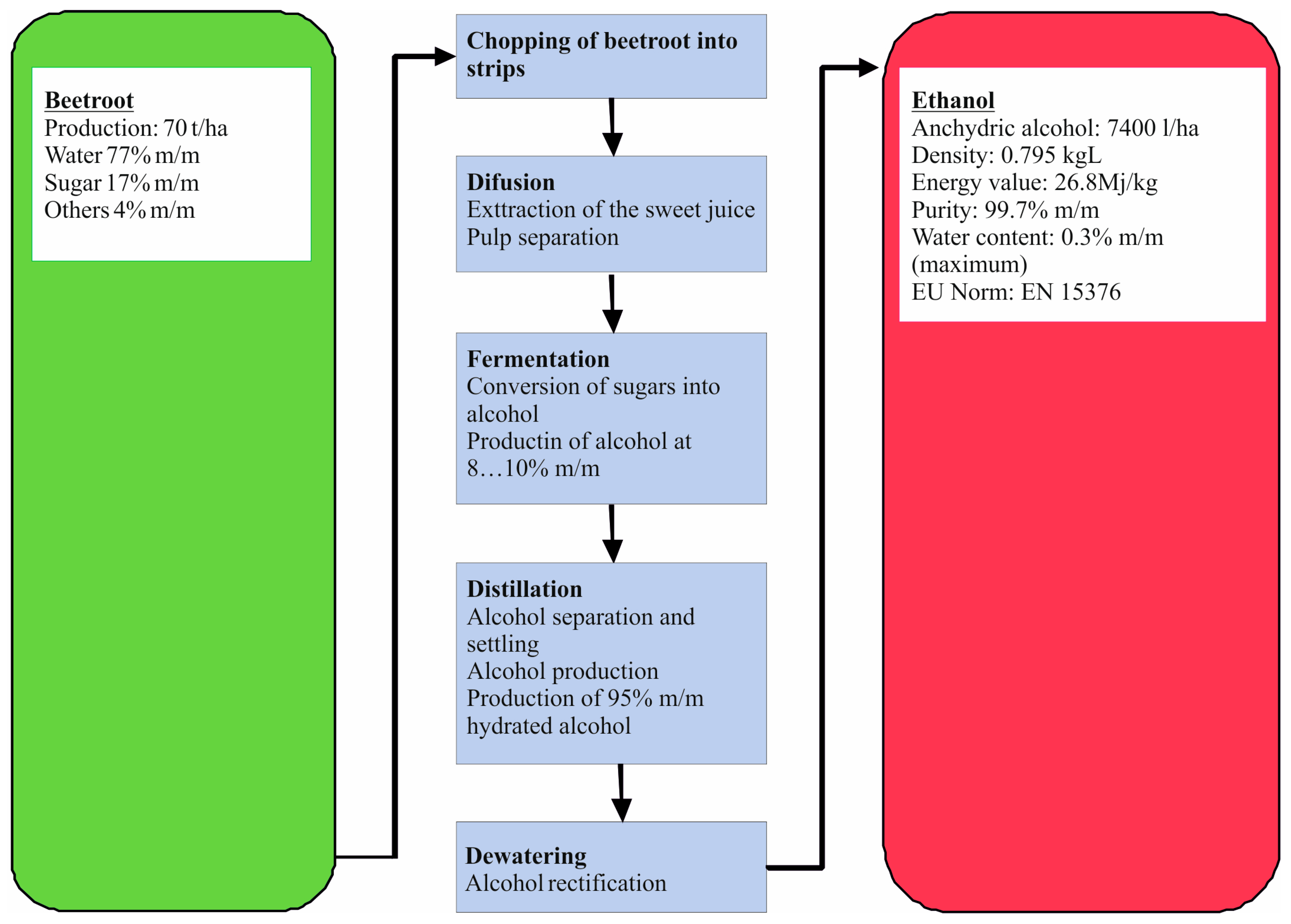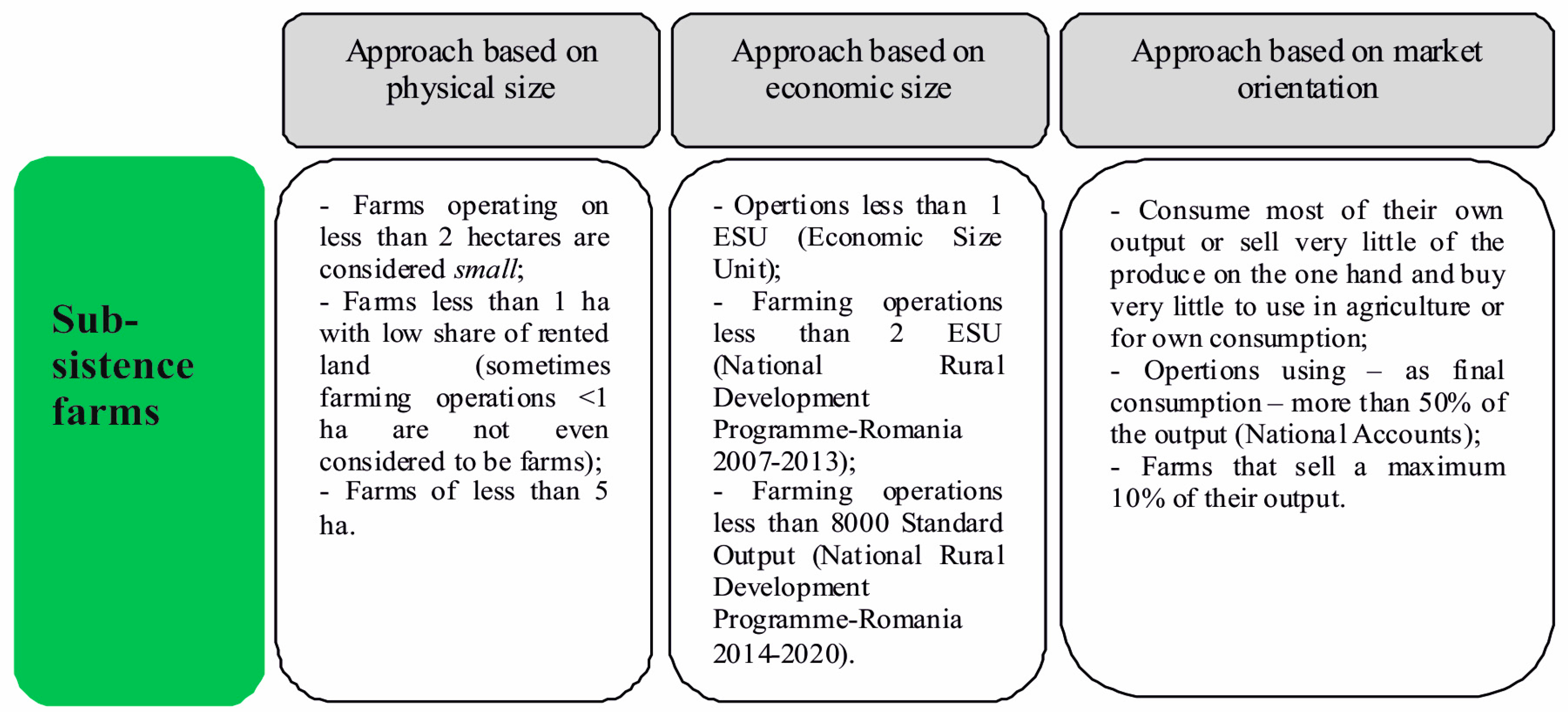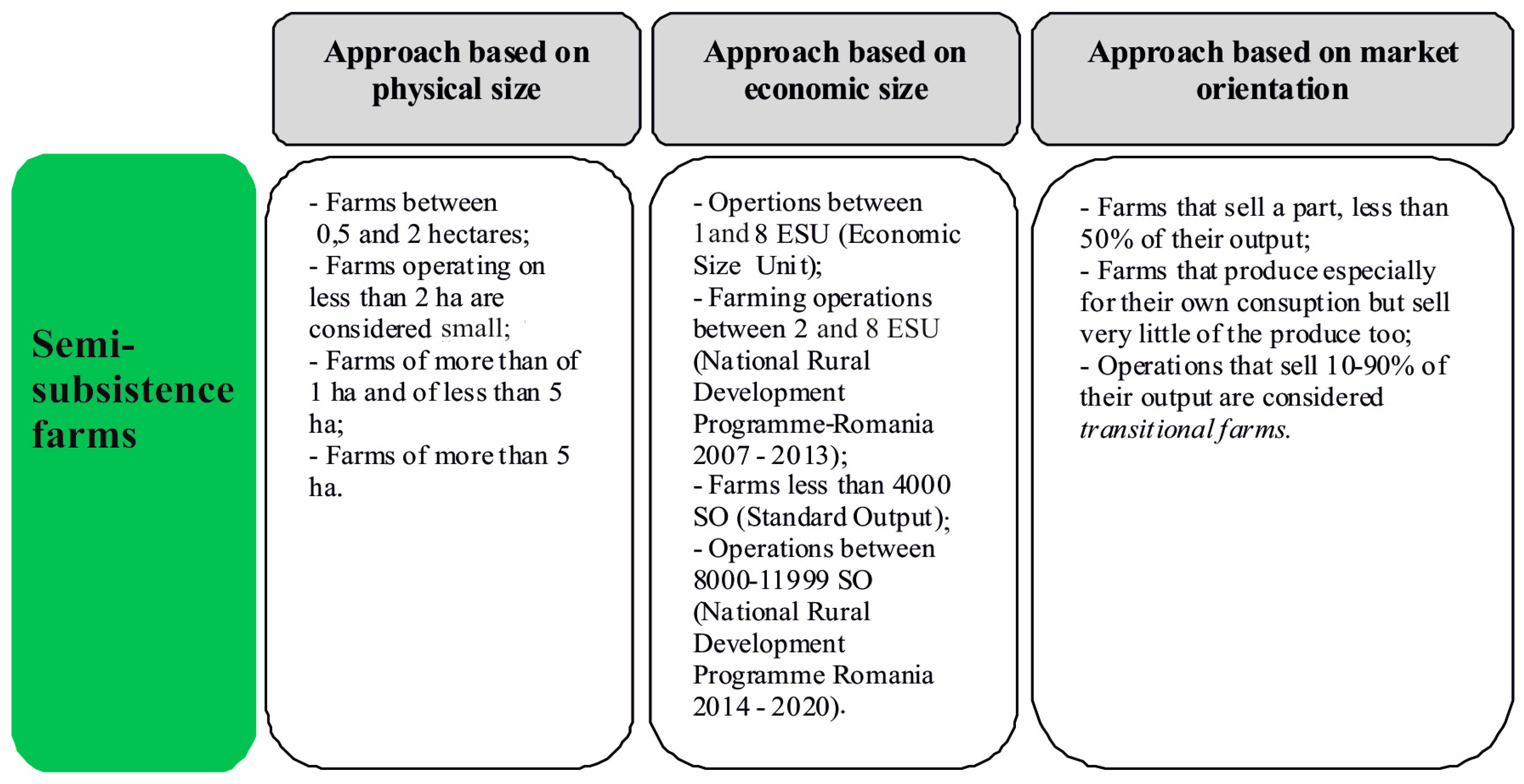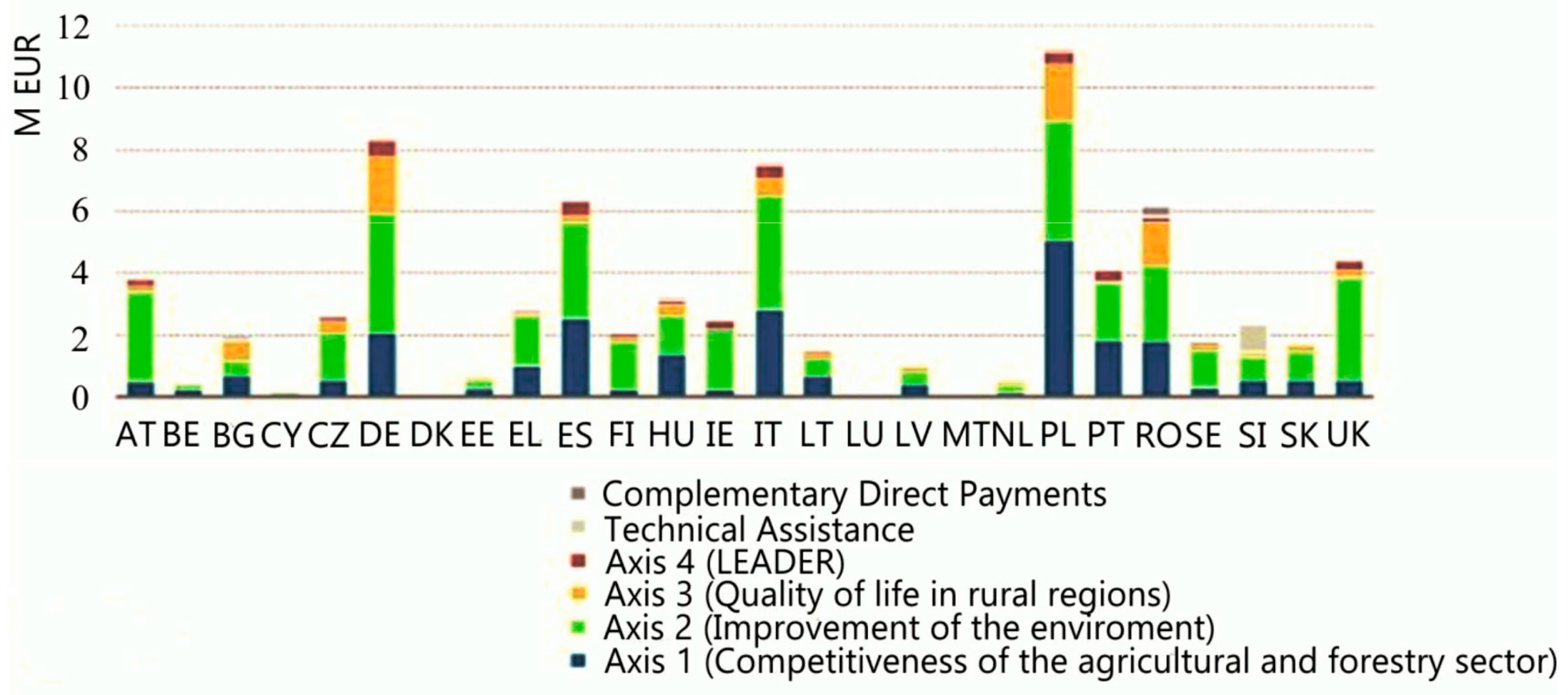Rural Economy and Bioethanol Production
Abstract
:1. Introduction
“As we know from its beginnings, Community Supported Agriculture is not just a clever, new approach to marketing. Community farming is about the necessary renewal of agriculture through its healthy linkage with the human community that depends upon farming for survival”.[1]
2. Description of the Study Area
2.1. A Brief Review of Literature
- Food source: Ethanol may be obtained from any plant crop containing high sugars or components to be turned into sugars, such as starch or cellulose, for example sugar beet and cane, containing natural sugar. Crops such as maize, wheat and barley contain starch that can be easily turned into sugar. Most trees and grasses contain cellulose, which can also be turned into sugar, although not as easily as starch.
- Wood cellulose: Another raw material in the manufacturing of ethanol and carbohydrates, obtained in the acid hydrolysis of cellulose from wood scrap, reeds, etc., are equally used in obtaining alcohol, which comes out in small quantities of methanol contamination. The use of bisulphite leaches from the cellulose industry was also attempted in obtaining ethanol.
- (1)
- Heat exchanger
- (2)
- Agitator
- (3)
- Synthesis column (hydractor)-reactor
- (4)
- Condenser
- (5)
- Gas separator
- One reason reflects the impact of the weather changes upon the Romanian agriculture and the improper infrastructure in order to counterattack the related risks. In this context, the weather changes represent a challenge in terms of the stability of crops and provision of the food security.
- Another reason lies in the general trend of extending the cultivated areas and low usage of the chemical products in agriculture, when a number of agricultural lands were affected by the incorrect use of the chemical fertilizers and pesticides, irrigations, drainage or the implementation of certain inadequate mechanical works, thus generating a strong degradation of the environment components (mainly soil and water) on small surfaces.
- Similarly, the abandonment of the agricultural activities and the defective agricultural practices emerged from the lack of pertinent knowledge or limited financial resources had a negative impact upon biodiversity and triggered the emergence or the accentuation of the soil erosion phenomenon.
- In default of concrete data to be examined, it becomes difficult to estimate the percentage of the abandoned agricultural land that was meant to accommodate agrarian works but it can be pinpointed those areas where the phenomenon is more intense. The abandonment affects Romania in the areas with a higher poverty line that is characterized by an increased emigration and on the outskirts of the large cities, where certain agricultural lands are pulled off their expected use in order to serve to the projects of extending the residential or commercial areas.
- the farmland is held “in trust” for the community;
- the farm is managed by a community group or cooperative;
- the farmers are involved on a long term, residing on or near the farmland;
- the farm production is focused on local foods obtained through sustainable farming practices;
- multiple activities are conducted to complement food production; and
- the property owners, the farmland supervisors, the farmers and working partners of the community farm are bound by an agreement [15].
- New forms of ownership: The land should be shared in proprietorship by a community under a legal trust that will then give it to the farmers on a rental agreement.
- New forms of cooperation: A network of human relationships should replace the traditional system of employers and employees.
- New forms of economy: The real needs of the people and land should be put in place of the profit and growth criteria of the economy.
2.2. The Romanian Farming Structure vs. Needs/Shortages
- most of them have almost no market relationship;
- the land farming structure in Romania has not changed significantly in the past decade, still remaining with the same extreme fragmentation and polarity, an important impediment to the increase of competitiveness in the sector [23]; and
- the farm consolidation process is very slow, with a slight increase in the average farm size of 0.3 ha: from 3.1 ha in 2002 to 3.4 ha in 2010 [24]. In this context, the product capitalisation process becomes very difficult.
3. Economic Development and Community Policies of Rural Development
- P1.
- Fostering knowledge transfer and innovation in agriculture, forestry, and rural areas.
- P2.
- Enhancing farm viability and competitiveness of all types of agriculture in all regions and promoting innovative farm technologies and the sustainable management of forests.
- P3.
- Promoting food chain organisation, including processing and marketing of agricultural products, animal welfare and risk management in agriculture.
- P4.
- Restoring, preserving and enhancing ecosystems related to agriculture and forestry.
- P5.
- Promoting resource efficiency and supporting the shift towards a low carbon and climate resilient economy in agriculture, food and forestry sectors.
- P6.
- Promoting social inclusion, poverty reduction and economic development in rural areas.
- ◾
- Rural employment. In Romania, the numbers in this section registered a decreasing trend before 2011 and it was repeated after 2012. With no information to back up this statement, a possible cause has been hypothesized as the effect that the financial recession had on the business operations and general employment.
- ◾
- CAP action and employment-related impacts. For 2008–2015, the monitoring instruments chosen to implement the system provided data to prove that the European Fund for Agriculture and Rural Development, more exactly via its national instrument the National Rural Development Programme, created an estimated number of 8723 jobs, targeting 54,288 work places.
- (1)
- Rural economies depend on a sufficiently high concentration of wealthy farmer families producing a range of raw materials/goods to maintain the diversity of local economy and able to spend money on other local goods and services.
- (2)
- Small farmers may rarely be wealthy unless they associate into cooperatives to ensure more bargaining power in the value adding chains; cooperatives may add value by adjusting supply to the preferences of the final customers on that market.
- (3)
- Rural economies must add value at the local level, as much as possible to primary raw materials, which will generate and ensure that local jobs are preserved in the associated processing enterprises, as well as increase the positive effects of the local economic multiplier.
- (4)
- The families of the work force involved in the primary or processing sectors should be considered in order to ensure a sufficient quality of life.
- Market measures: To consolidate the position of farmers in the supply chain of food and new instruments to be dedicated to farmers, enabling them to get better organised in cooperatives in order to improve the balance in the supply chain with a supply of indigenous foods.
- Support for key priorities in Bulgarian rural development: For 2014–2020, Bulgaria has allocated about 2.3 billion euro to measures targeting the rural areas, with the expenditure sum according to the priorities defined in the Programme.
- more than 4900 farmers (accounting for 841,000 ha) received agro-environment support; and
- nearly 1400 farms (accounting for 71,000 ha) were supported for ecological agriculture.
4. Preserving Ecosystems and Sustainable Use of Natural Resources in Agriculture
4.1. The Role of the Organic Farming Community
4.2. The Competition for Cultivating the Lands for Food versus Energy
5. Conclusions and Recommendations
- development of a regulation framework to support both the industrial policy and the technological improvement; and
- a functional market of carbon and taxes on energy attracting investors by clear and strong incentives so that they will invest in low carbon emission technologies and in their development.
- conversion of animal waster into biogas;
- a higher efficiency of the agricultural technique; and
- improvement of the carbon pit function of the agricultural soils.
Conflicts of Interest
References
- McFadden, S. Rodale Institute, newfarm.org. Farms of Tomorrow: Community Supported Farms, Farm Supported Communities. Available online: http://newfarm.rodaleinstitute.org/features/0204/csa2/part2.shtml (accessed on 7 August 2016).
- Boróka, B.J. Locul si Rolul Fermelor Mici in Ruralul Romanesc si Evolutia Acestora sub Impactul Politicii Agricole Comune; Editura ASE: Bucuresti, Romania, 2015. (In Romanian) [Google Scholar]
- Mulligan, C.B. The impact of health reform on employment and work schedules. Am. J. Med. Res. 2015, 2, 5–40. [Google Scholar]
- Frechette, S. Food marketing as a relevant determinant of childhood obesity. Am. J. Med. Res. 2015, 2, 182–187. [Google Scholar]
- Sharp, E. (Intra-)activity of alternative food: Performing a hopeful food future. Geopolit. Hist. Int. Relat. 2016, 8, 7–21. [Google Scholar]
- Havu, K. EU Law in Member State Courts. Contemp. Read. Law Soc. Justice 2016, 8, 158–187. [Google Scholar]
- Istudor, N.; Petrescu, I.E. The role of consultancy in the process of applying for European funds for rural development. In Proceedings of the International Conference Organized by the European Association of the Agrarian Economists: The Role Knowledge, Innovation and Human Capital in Multifunctional Agriculture and Territorial Rural Development, Belgrade, Serbia, 9–11 December 2009; pp. 169–174.
- Uhrig, S.C.N. Poverty in the UK: A review and top-line findings from the UK household longitudinal study. J. Res. Gend. Stud. 2015, 5, 23–72. [Google Scholar]
- Popescu, G.H. ICT’s potential in reducing GHG emissions through sustainable manufacturing technologies. J. Self-Gov. Manag. Econ. 2015, 3, 66–71. [Google Scholar]
- Dragancea, D. WordPress.com. Available online: https://draganceadaniela.wordpress.com/2013/02/09/producerea-etanolului (accessed on 5 June 2016).
- Energii Regenerabile. Available online: http://www.naturenergy.ro (accessed on 30 September 2016). (In Romanian)
- Madr.ro. Dezvoltare Rurala. Available online: http://www.madr.ro/docs/dezvoltare-rurala/rndr/buletine-tematice/PT10.pdf (accessed on 25 September 2016). (In Romanian)
- Fonduri Structurale. Analiza Economico-Sociala a Dezvoltarii Rurale. Available online: http://www.fonduri-structurale.ro/Document_Files/fs2014-2020/00011282/ovnoj_Analiza-socio-economica-dezvoltare-rurala%20-%20draft%201.pdf (accessed on 23 September 2016). (In Romanian)
- Wikipedia.org. Farming: History and Types. Available online: https://en.wikipedia.org/wiki/Farm (accessed on 3 July 2016).
- A Guide to Setting up and Running Community Farms. Available online: http://www.feanetwork.org/wp-content/uploads/2014/08/A-guide-to-setting-up-and-running-Community-Farms.pdf (accessed on 27 September 2016).
- Wikipedia.org. Community-Supported Agriculture. Available online: https://en.wikipedia.org/wiki/Community-supported_agriculture (accessed on 3 July 2016).
- Hubbard, C.; Mishev, P.; Ivanova, N.; Luca, L. Semi-Subsistence Farming in Romania and Bulgaria: A Survival Strategy? Case Stud. Euro Choices 2014, 13, 46–51. [Google Scholar] [CrossRef]
- Bíró, B.J. Regional Absorption of CAP Rural Development Funds Targeted for Semisubsitence Farms in Romania in the 2007–2013 Programming Period. Romanian Rev. Reg. Stud. 2015, XI, 69–76. [Google Scholar]
- Giurcă, D. Revista Lumii Agricole. Profilul Agricol. Clarificări Necesare Pentru Fermele de Semi-Subsistenţă. Available online: http://www.agrinet.ro/content.jsp?page=83&language=1 (accessed on 7 July 2016). (In Romanian)
- Davidova, S.; Gorton, M.; Fredrikkson, L. European Commission, European Network for Rural Development. Semi-Subsistence Farming in Europe. Concepts and Key Issues. Available online: http://enrd.ec.europa.eu/app_templates/filedownload.cfm?id=FB3C4513-AED5-E24F-E70A-F7EA236BBB5A (accessed on 7 July 2016).
- Burrell, A.; Fritzsch, J.; Wegener, S.; Buchenrieder, G.; Curtiss, J.; Paloma, S.G. European Commission JRC Scientific and Technical Reports, IPTS. Economic Prospects for Semi-Subsistence Farm Households in EU New Member States, JRC IPTS. 2010. Available online: http://www.eurosfaire.prd.fr/7pc/doc/1288944317_jrc58621.pdf?PHPSESSID=2ce624f5abd82bbe99181a0445724577 (accessed on 8 July 2016).
- Fritzsch, J.; Wegener, S.; Buchenrieder, G.; Curtiss, J.; Paloma, S.G. Is there a future for semi-subsistence farm households in Central and southeastern Europe? A multiobjective linear programming approach. J. Policy Model. 2011, 33, 70–91. [Google Scholar] [CrossRef]
- Luca, L.; Cionga, C.; Giurcă, D. Consolidarea Exploataţiilor Agricole; Editura Economică: Bucureşti, Romania, 2012. (In Romanian) [Google Scholar]
- Alexandri, C.; Luca, L. The role of small farms in Romania and their future in the face of challenges of the CAP post 2013. Probl. Small Agric. Hold. 2012, 1, 13–30. [Google Scholar]
- Cionga, C.; Luca, L.; Hubbard, C. The impact of direct payments on Romanian farm income: Who benefits from the CAP? In Proceedings of the 109th EAAE Seminar, the CAP after the Fischler Reform: National Implementations, Impact Assessment and the Agenda for Future Reforms, Viterbo, Italy, 20–21 November 2008.
- European Parliament, Directorate-General for Internal Policies. Research for AGRI Committee—The Role of the EU’s Common Agricultural Policy in Creating Rural Jobs. Available online: http://www.europarl.europa.eu/RegData/etudes/STUD/2016/573418/IPOL_STU(2016)573418_EN.pdf (accessed on 8 May 2016).
- Economy and Finance. EU. Available online: http://ec.europa.eu/economy_finance/publications/publication7718_en.pdf (accessed on 1 October 2016).
- Gazeta de Agricultura. Available online: http://www.gazetadeagricultura.info/fonduri-europene/17272-pndr-7-4-miliarde-de-euro-platite-fermierilor-83-grad-de-absorbtie-angajare-97-a-fonduriloreuropene.html (accessed on 15 June 2016). (In Romanian)
- Ministerul Agricultrurii si Dezvoltarii Rurale, Programul National de Dezvoltare Rurala 2014–2020. Available online: http://old.fonduri-ue.ro/res/filepicker_users/cd25a597fd-62/2014-2020/po/Prezentare.PNDR.2014–2020.pdf (accessed on 7 May 2016). (In Romanian)
- Peters, M.A.; Besley, T. Globalism, interconnectivity and the experiment of the open society. Geopolit. Hist. Int. Relat. 2016, 8, 112–126. [Google Scholar]
- Ştefănescu-Mihăilă, R.O. Social Investment, Economic Growth and Labor Market Performance: Case Study—Romania. Sustainability 2015, 7, 2961–2979. [Google Scholar] [CrossRef]
- Popescu, G.H. The dynamics of social innovation networks. Psychosoc. Issues Hum. Resour. Manag. 2015, 3, 77–82. [Google Scholar]
- Development in Agriculture and Rural Areas of Bulgaria, Velikov, Iordan. Available online: http://library.fes.de/pdf-files/bueros/belgrad/10399-20131211.pdf (accessed on 16 July 2016).
- Bulgaria. Common Agricultural Policy. European Commission. Available online: http://ec.europa.eu/agriculture/cap-in-your-country/pdf/bg_en.pdf (accessed on 1 June 2016).
- Agriculture & Rural Convention 2020.eu. Available online: http://www.arc2020.eu/2014/12/organic-farming-the-role-of-the-state-and-eu-subsidies/ (accessed on 4 June 2016).
- Andrieu, E. European Parliament. How Can the CAP Improve Job Creation in Rural Areas? Working Document of the Committee on Agriculture and Rural Development. Available online: http://www.europarl.europa.eu/sides/getDoc.do?pubRef=-//EP//NONSGML+COMPARL+PE-573.103+01+DOC+PDF+V0//EN&language=MT (accessed on 14 June 2016).
- Regulament (CE) nr. 1307/2013. Available online: http://www.apia.org.ro/files/pages_files/15-04-10-12-13-28PAC_2015-2020_verif_BT_24_10_2014MONICA.pdf (accessed on 30 September 2016). (In Romanian)
- Biotechnology for Biofuels. Available online: https://biotechnologyforbiofuels.biomedcentral.com/articles/10.1186/1754-6834-5-25 (accessed on 7 October 2016).
- Practicarea Agriculturii. Available online: http://www.muntiimaramuresului.ro/index.php/ro/traditie/practicarea-agriculturii (accessed on 10 October 2016). (In Romanian)
- National Agricultural Research and Development Institute. Available online: http://www.incda-fundulea.ro/activitate_en.htm (accessed on 9 October 2016).
- Basso, L.C.; Rosa, C.A. Sugar cane for potable and fuel ethanol. In Distilled Spirits. New Horizons: Energy, Environment and Enlightenment, Proceedings of the Worldwide Distilled Spirits Conference, Edinburgh, UK, 1 September 2008; Walker, G.M., Hughes, P.S., Eds.; Nottingham University Press: Nottingham, UK, 2010; pp. 1–7. [Google Scholar]
- International Renewable Energy Agency. Available online: http://costing.irena.org/technology-costs/transportation/bioethanol.aspx (accessed on 23 July 2016).
- Wall Street. Available online: http://www.wall-street.ro/articol/Companii/74837/Cum-arata-investitia-de-90-mil-euro-a-lui-Ioan-Niculae-in-bioetanol.html (accessed on 27 July 2016).
- Zietlow, K.J. What is left today? Analyzing OPEC’s influence on the crude oil price. J. Self-Gov. Manag. Econ. 2015, 3, 61–69. [Google Scholar]
- Stefanescu-Mihaila, O.R. Publicitatea si Dezvoltarea Durabila [Advertising and Sustainable Development]; Editura Expert: Bucuresti, Romania, 2014; pp. 47–55. (In Romanian) [Google Scholar]




| Utilized Agricultural Area | Total Number of Farm Holdings | Average Area Farm Size | Number of Farm Holdings | |||||||||
|---|---|---|---|---|---|---|---|---|---|---|---|---|
| With Less | With | With More | ||||||||||
| Than 5 ha | 5 ha–50 ha | Than 50 ha | ||||||||||
| 2013 `000 ha | 07/13 % | 2013 `000 ha | 07/13 % | 2013 ha/Farm | 07/13 % | 2013 `000 | 07/13 % | 2013 `000 | 07/13 % | 2013 `000 | 07/13 % | |
| EU Total | 174,600 | 0.7 | 10,840 | −21.5 | 16 | 28.3 | 7014 | −26.1 | 2928 | −13.8 | 899 | −2.5 |
| EU-15 | 124,600 | 0.1 | 4440 | −20.6 | 28 | 26.0 | 2033 | −31.4 | 1742 | −11.0 | 665 | −0.6 |
| EU-10 | 30,800 | −1.2 | 2360 | −34.7 | 13 | 51.5 | 1379 | −44.5 | 856 | −13.9 | 125 | −8.3 |
| Examples | ||||||||||||
| BG | 4700 | 52.5 | 250 | −48.4 | 19 | 197.2 | 211 | −53.7 | 24 | 27.1 | 19 | 7.4 |
| RO | 13,100 | −5.1 | 3630 | −7.7 | 4 | 2.8 | 3281 | −4.9 | 262 | −32.1 | 86 | −8.2 |
| PL | 14,400 | −6.9 | 1430 | −40.2 | 10 | 55.3 | 770 | −52.6 | 620 | −15.1 | 39 | 13.1 |
| IT | 12,100 | −5.1 | 1010 | −39.8 | 12 | 58.5 | 592 | −51.8 | 372 | −8.9 | 46 | 10.8 |
| HU | 4700 | 10.1 | 490 | −21.6 | 10 | 43.9 | 377 | −24.5 | 62 | −14.0 | 52 | −27.6 |
| IE | 5000 | 19.8 | 140 | 8.9 | 36 | 13.2 | 10 | 19.3 | 105 | 7.8 | 25 | 9.7 |
© 2016 by the author; licensee MDPI, Basel, Switzerland. This article is an open access article distributed under the terms and conditions of the Creative Commons Attribution (CC-BY) license (http://creativecommons.org/licenses/by/4.0/).
Share and Cite
Ștefănescu-Mihăilă, R.O. Rural Economy and Bioethanol Production. Sustainability 2016, 8, 1148. https://doi.org/10.3390/su8111148
Ștefănescu-Mihăilă RO. Rural Economy and Bioethanol Production. Sustainability. 2016; 8(11):1148. https://doi.org/10.3390/su8111148
Chicago/Turabian StyleȘtefănescu-Mihăilă, Ramona Olivia. 2016. "Rural Economy and Bioethanol Production" Sustainability 8, no. 11: 1148. https://doi.org/10.3390/su8111148





